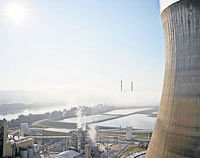
Poking out of the ground near the smokestacks of the Mountaineer power plant are two wells that look much like those that draw natural gas to the surface. But these are about to do something new: inject a power plant’s carbon dioxide into the earth.
A behemoth built in 1980, long before global warming stirred broad concern, Mountaineer is poised to become the world’s first coal-fired power plant to capture and bury some of the carbon dioxide it churns out. The hope is that the gas will stay deep underground for millennia rather than entering the atmosphere as a heat-trapping pollutant.
The experiment, which the company says could begin in the next few days, is riveting the world’s coal-fired electricity sector, which is under growing pressure to develop technology to capture and store carbon dioxide. Visitors from as far as China and India, which are struggling with their own coal-related pollution, have been trooping through the plant.
The United States still depends on coal-fired plants, many built decades ago, to meet half of its electricity needs. Some industry experts argue that retrofitting them could prove far more feasible than building new, cleaner ones.
Yet the economic feasibility of the Mountaineer plant’s new technology, known as carbon capture and sequestration, remains uncertain. The technology is certain to devour a substantial amount of the plant’s energy output: optimists say 15 per cent, and skeptics, 30 per cent.
Will carbon dioxide stay put?
And as with any new technology, even the engineers are unsure how well it will work: Will all of the carbon dioxide stay put?
Environmentalists who oppose coal mining and coal energy of any kind worry that sequestration could simply trade one problem, global warming, for another one, the pollution of water supplies. Should the carbon dioxide mix with water underground and form carbonic acid, they say, it could leach poisonous materials from rock deep underground that could then seep out.
Given the depths to which workers have drilled, they also fret that the project could cause earthquakes, although experts at the Environmental Protection Agency discount the risk of catastrophe.
“Coal is the drug of choice of a major industry with a lot of political power,” said David H Holtz, executive director of Progress Michigan, an environmental group. Instead of adopting carbon capture, which Holtz likens to a methadone cure for addiction, he argues that the industry would do better to go cold turkey.
“There’s no evidence that burying carbon dioxide in the earth is a better strategy than pursuing other alternatives that clearly are better for the environment and will in the long run be less costly,” Holtz said.
Engineers will begin pumping carbon dioxide, converted to a fluid, into a layer of sandstone 7,800 feet below the rolling countryside here and then into a layer of dolomite 400 feet below that. The liquid will squeeze into tiny pores in the rock, displacing the salty water there, and assume a shape like a squashed football, 30 to 40 feet high and 100s of yards long.
American Electric Power’s plan is to inject about 100,000 tons annually for two to five years, about 1.5 per cent of Mountaineer’s yearly emissions of carbon dioxide. Should a law be passed to control carbon dioxide emissions and the new technology proves economically feasible, the company says, it could then move to capture as much as 90 per cent of the gas.
Two wells and a chemical factory
For now, the project consists of two wells and a small chemical factory. In the factory, smoke diverted from the plant’s chimney is mixed with a chilled ammonia-based chemical. The chemical is then heated, releasing the carbon dioxide, which is pumped deep into the wells. For energy planners, a crucial question is how much this technology would cost if refined and installed on a bigger scale. The answer remains elusive.
Still, scientists emphasise that Mountaineer is within miles of four other big coal plants with a combined capacity of 6,000 megawatts, a concentration so great that industry insiders have nicknamed the area Megawatt Alley.
Far larger projects for capturing and storing carbon dioxide have been under way for years in Europe and North Africa. In North Dakota, the Great Plains Synfuels plant, which converts methane to natural gas, takes the leftover carbon dioxide and pumps it through a pipeline to Canada to stimulate oil production there. But Mountaineer is the world’s first electricity plant to capture and store carbon dioxide.
Asked whether the injections of carbon dioxide could increase the frequency or magnitude of small earthquakes, an EPA official said it seemed unlikely.
NYT News Service